Every stable needs scratching posts for horses. Equine scratching posts are a must have item for healthy skin, coats, and minds. Giving your horse the chance to scratch on the right material prevents damage to property and manes and tails – and it improves your horse’s quality of life. And the best part is that there’s no need to break the bank on storebought scratchers! These DIY scratching post textures offer options from rough to soft, so you can create the perfect scratching station.
What is a scratching post for horses?
Have you ever been curious about a cool stable scratcher on Pinterest? Wondered “What are scratching posts for horses, anyway?” They sure look fun, but what’s their purpose?
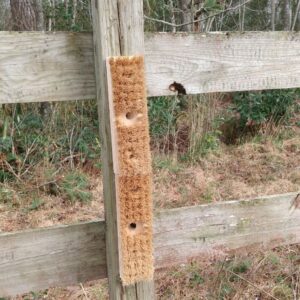
Scratching post for horses and stable scratch pads are fun for your horse, but they’re also important. They give your horse the chance to groom themselves, and do some equine self-care.
Self-care, technically called self-maintenance, is how horses maintain their bodies. Scratching against objects is an important self-maintenance behavior. It helps horses groom their hair and skin, along with rolling on the ground, scratching themselves with their teeth and hooves, and having a mutual grooming session.

Scratching posts are freestanding posts, usually wood, that have textured scratching material attached. Scratching pads or scratching panels for stalls are similar, but are mat-shaped and attach to the stall wall.
Why do horses need scratching posts?
A scratching post for horses gives your equine friend a safe and effective place to scratch.
There are places on a horse’s body that they just can’t scratch using teeth or hooves. And even the best cared for horses can get very itchy from time to time.
Scratching an itch feels fantastic to your horse, just like for you. Horses will scratch anywhere they can find. Unfortunately, many stalls and paddocks don’t have good places for scratching.
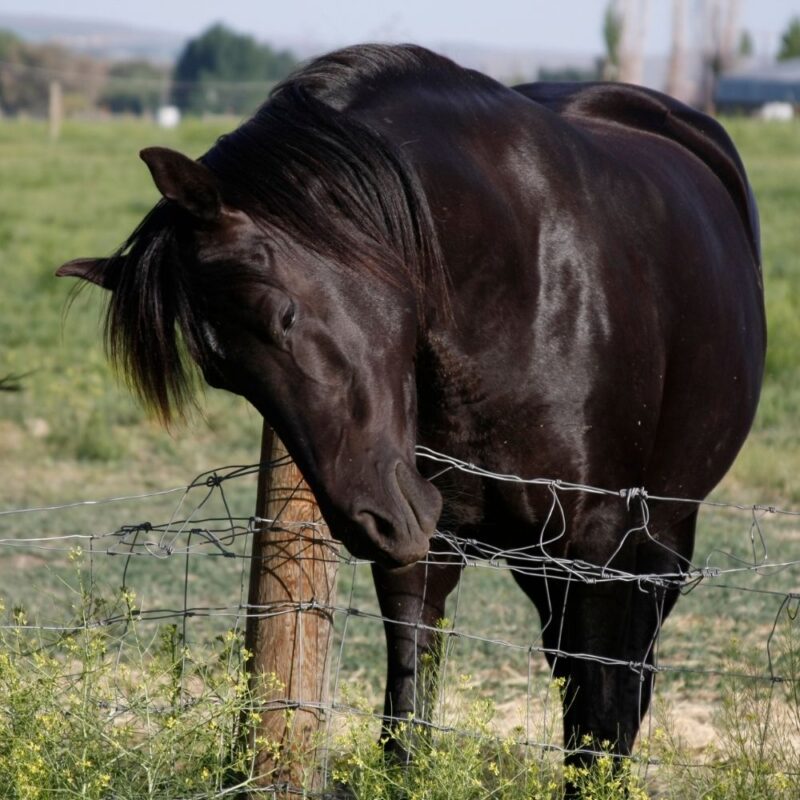
In a stall, there may be no surfaces where a horse can scratch effectively. Paddocks with wire fencing and no trees are similar. Scratching pads or scratching posts provide a crucial location for relieving itches.
Even if your horse does have scratchable objects, they may not be your first choice for self-grooming. Rubbing and pushing can damage fences, trees, and walls. It can also rub or pull out hair from your horse’s mane, tail, or coat, or create a safety hazard for eyes and skin.
A scratching post gives your horse a perfect place to scratch – it’s important enrichment and keeps your fencing and buildings healthy. Enrichment for horses isn’t all about fun toys and activities. Giving your horse opportunities to behave naturally (like scratching!) in a productive way is what enrichment is all about!
Creating a DIY horse scratching post will keep your wallet healthy, too.
DIY Horse Scratching Posts Overview
Making a DIY scratching post or stall scratching pad isn’t difficult. Horses love freestanding posts, and you can create one in a weekend with a 4×4 post, some bagged concrete mix, and a post hole shovel.
If you can’t add a freestanding post, you can install any of the textures in this article on a wooden fencepost, or use a solid wall by creating a wall mounted scratching board. That link will be at the end of this article, so you can keep reading about textures and follow up when you’re done.
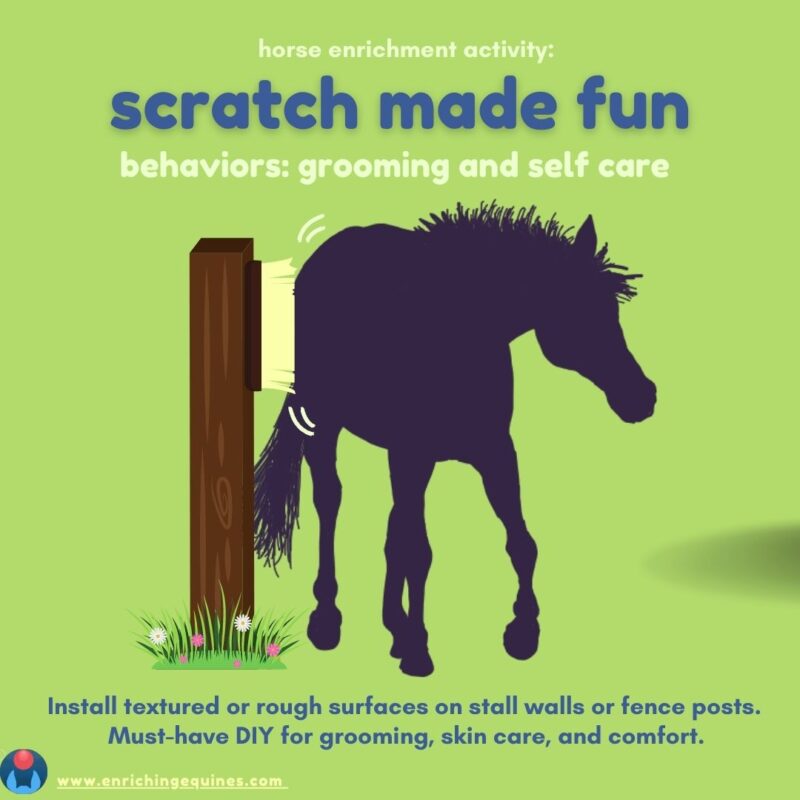
4×4 wood posts make ideal scratchers in the pasture. For safety, they should be at least as tall as your horse’s withers. Short scratching posts are harder for your horse to use and are a safety hazard.
DIY freestanding wood scratching posts should be anchored deep in the ground and set in concrete. They’ll need to take the whole weight of your horse, so don’t skimp on the installation!
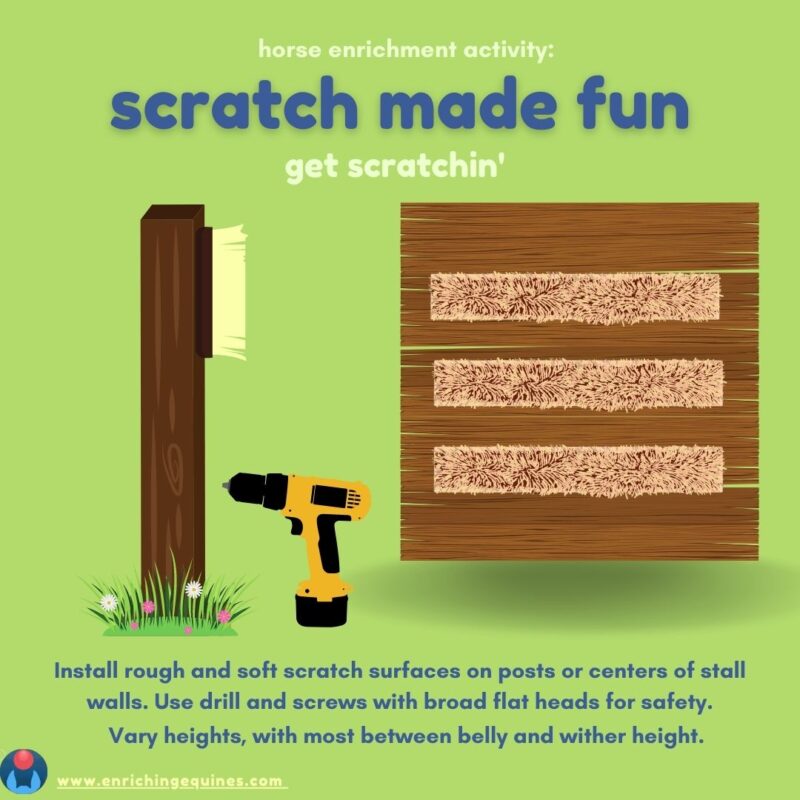
In the stall, use a clear patch of stall wall – the middle of a wall is easiest for your horse to access.
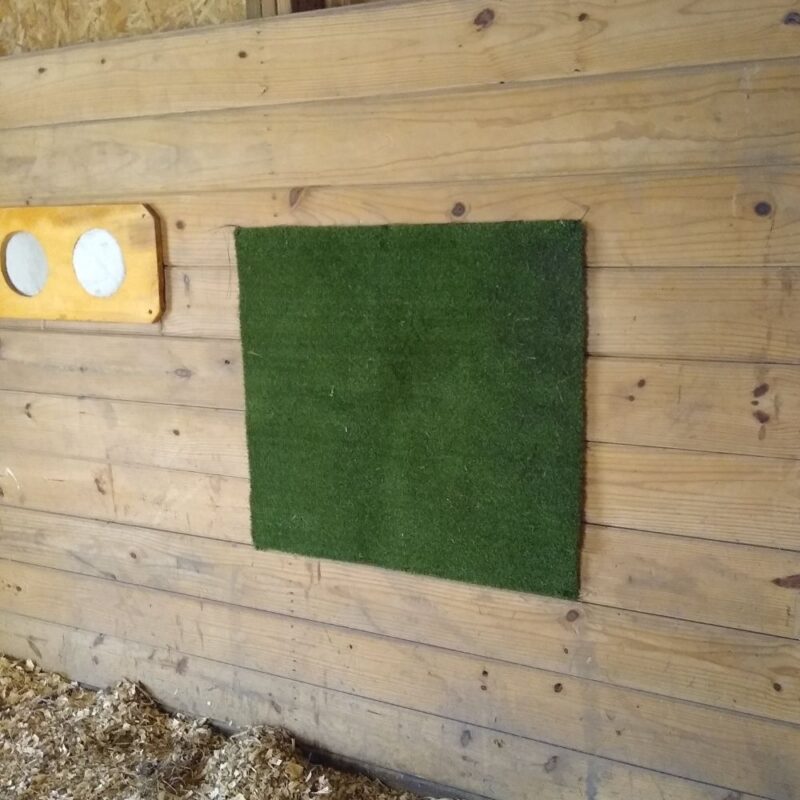
Pick a material from the list below, and use a drill to screw the scratch material to the post or wall. For most thin materials, short screws with broad, flat heads like these are the safest and most effective option. Scrub brush heads will need longer screws.
Using screws is important for safety – and safety is important for enrichment. Nails can back out of th post over time, creating a sharp edge that risks injury. Screws stay tight and secure even with long term use.
But which material to use for your DIY scratching post? Check out these options for scratching success!
DIY Horse Scratching Post Option 1: Scrub Brushes
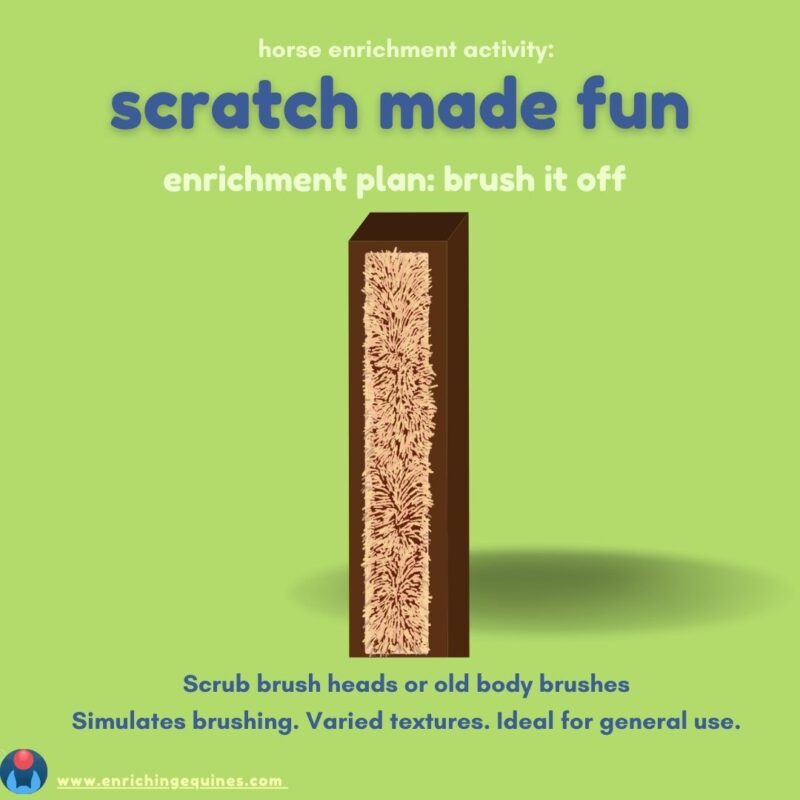
A used dandy brush or scrub brush makes an ideal scratcher! You probably have several well used brushes around the stable, so take a few and create your horse’s new favorite enrichment item.
Brushes make budget friendly, durable scratching options. Deck brushes or flat-headed scrub brushes from the local hardware store are also fantastic and economical. DIY brush scratching posts the roughest textured option, and is especially great for horses with intense itches or long coats.
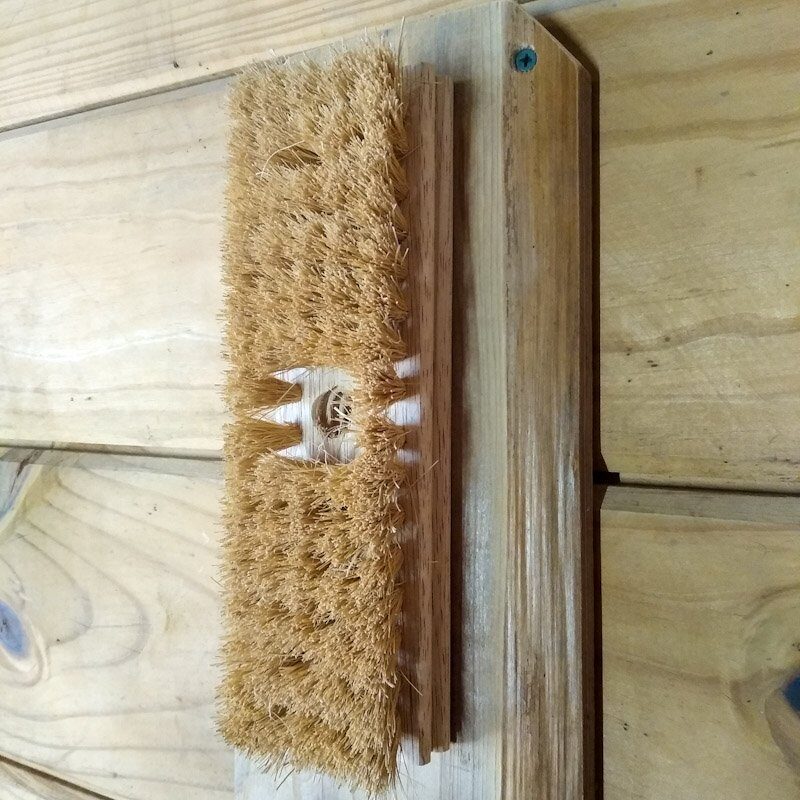
It’s best to install brushes by first drilling pilot holes in the brush itself. This prevents splitting when you attach it to the stall wall or post. You’ll find full instructions here.
Scratching Post Option 2: Coconut Fiber Mat
These natural fiber mats are just slightly less rough than the deck brush, and they make perfect firm scratching pads. Coconut fiber door mats are easy to find, and chances are you or your friends have one at home that’s ready to be replaced. Right on budget!

Coconut fiber door mats can be used in one piece as a stall scratching board for a generously sized scratching station. To use them on a free standing scratching post, it’s best to cut the mat into strips and attach to each side of the post. Most coconut fiber door mats are thick and don’t bend tightly.
Before repurposing a coconut fiber door mat as a DIY horse scratcher, make sure it’s completely clean. Hose it thoroughly and brush it down with a little bit of soap to remove dirt and debris.
Coconut fiber mats may be loosely woven. To install them, add a fender washer like this to each screw.
Scratching Post Option 3: Astroturf and Synthetic Grass

You can make a fantastic and really attractive DIY horse scratching post using AstroTurf, stadium turf, or rough synthetic grass.
This material has several advantages. It’s moderately rough, so it’s good for a wide range of horses and scratching needs. The type of turf shown here can scratch itches on any part of the body including thin skinned areas, and won’t damage names and tails.

Also, synthetic turf is made of plastic and can be completely disinfected. This is ideal for vet clinics, rescues, or quarantine stalls.
Synthetic turf is easiest to cut with a serrated kitchen knife – seriously! – and it’s possible to get nice precise pieces for a tidy look on any paddock or stable scratching station.
Synthetic turf is sold by the roll, but if you don’t want to buy a large amount or want to reduce your consumption of new plastics, call up a few local golf courses, activity centers, or lawn management companies and ask about scrap.
Scratching Post Option 4: Rubber Floor Mat
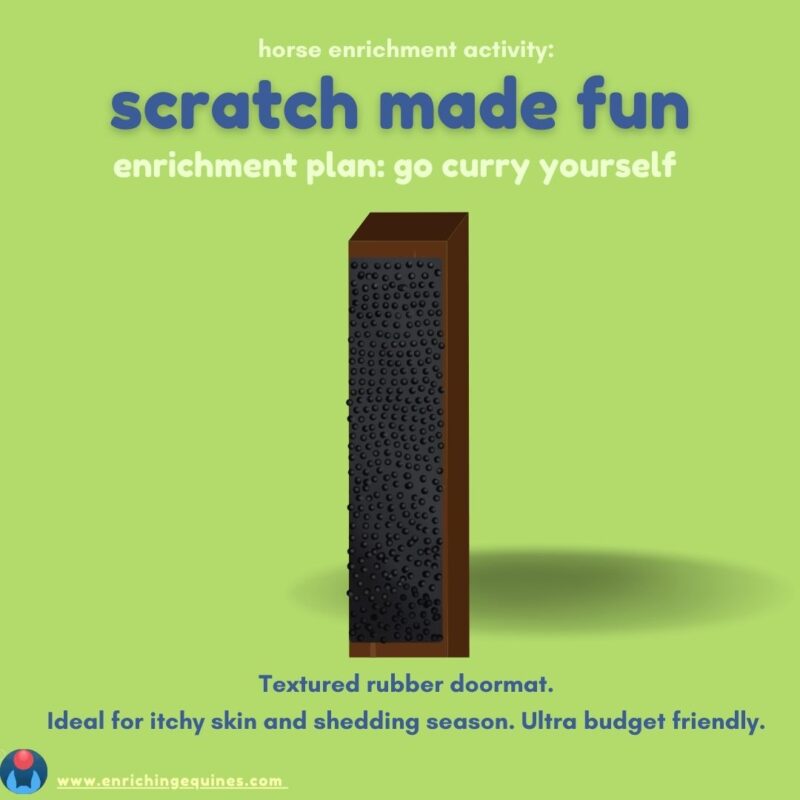
It’s true: doormats make ideal DIY horse scratch pads. For a change of pace from the coconut fiber mat, use a textured rubber mat for a DIY horse scratching post. It’s a lot like giving your horse its own rubber curry comb.
This scratch mat option is ideal for shedding horses, or horses that have especially itchy skin. A rubber mat scratching post is gentle on sensitive areas, like the face. Like the synthetic turf mat, it can be completely sanitized between horses.

Rubber mats are extremely budget-friendly and easy to use. You can cut most of them with scissors. The material. Most rubber mats are fairly thin, so use extra screws to install them and add washers to spread the surface area and eliminate tearing.
DIY Horse Scratching Post Option 5: Microfiber Chenille
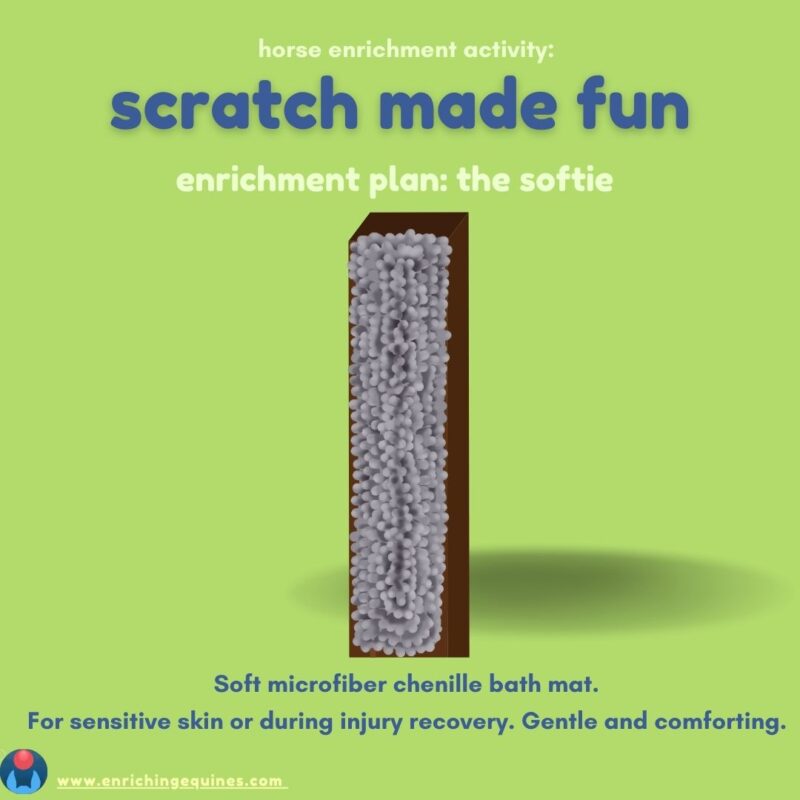
Soft and fluffy, chenille should be used in addition to other scratching options for most horses. By itself, it doesn’t have the rough texture needed to really relieve itches. But microfiber chenille cloth is gentle and soft, providing a soothing texture for rubbing and low-intensity scratching.
Horses with very sensitive skin may find it appealing. It’s also good at providing sensory input as part of a texture board.
Bath mats made from this material are easy to find in discount stores. They’re also popular as cleaning fabrics – chenille dusting mittens can be washed and repurposed in the stable.
So Many Scratching Posts!
With all these options, you can create a DIY scratching post or scratch pad that fits your horse’s unique needs. Add several textures whenever possible for maximum enrichment value, and don’t forget to install a scratcher in both your horse’s paddock and stall if possible.
Visit this article for the DIY scratching board, which is great for stalls, pasture shelters, or wood fences.
And if your horse is extra itchy, how about a scratching session with you? It’s perfect for building a relationship. Here’s the right way to safely and effectively scratch your horse.
Scratching an itch never felt so good!